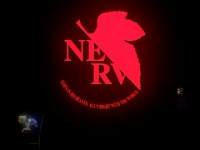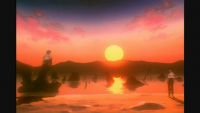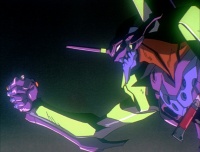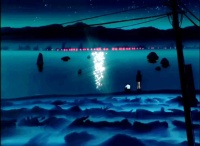
|
"Making something... Nurturing something is really great. You can see and learn so many things from the process."
Please help improve this article or section by expanding it.
Please discuss this issue, or begin editing the page.
|
Evangelion'a genellikle anlatı olarak bakılır, ancak onu sinematografinin teknik düzeyinde ve özellikle bu denemede montaj düzeyinde de değerlendirmek gerekir. Animede birkaç montaj dizisi var, ancak bunların en dikkat çekicileri 14, 22 ve 26'. bölümlerde tezahür ediyor. Başkaları da olsa, bu üç bölümdeki montaj sekansları, bu kritik makalenin ilk baskısında incelenecek.
Bu sayfa Kullanıcı: Ran1'in sayfasından uyarlanıyor, çoğunlukla orijinal yazardan alınan materyallerle. Bunu tartışmak isterseniz lütfen ona başvurun.
Klasik Montaj Teorisine Giriş
Montaj teorisi, Sovyet film yapımcısı/kuramcısı Sergei Eisenstein tarafından 1922'de ufuk açıcı sinema incelemesi Film Biçimine Diyalektik Bir Yaklaşım ile geliştirildi. Bu inceleme, özet olarak, teoriyi şu terimlerle sundu:
- 1. Montajdaki imgeler, ayrı kimlikler olarak var olmanın apaçık nedeni ile orada değildir. Montaj dizisinin kilit yönü, görüntülerin hepsinin birbirine bağlı olmasıdır. Her görüntünün anlamı, önceki ve ardışık görüntüler tarafından inşa edilir ve üzerine inşa edilir.
- 2. Eisenstein'a göre, montaj teorisi “sinemanın özgül problemini”, ortam özgüllüğünü çözdü.
- 3. Montaj özünde, önceki iki görüntüden eksik olan alt metnin birbiriyle “çarpıştırıldığı” ve montajın sonunda daha yeni, tam bir anlam sunduğu “görüntüler arasındaki bir çatışma”dır.
Bu teorinin Evangelion'daki bir uygulaması şu çekim dizisi olabilir:
| Montaj Sırası
|
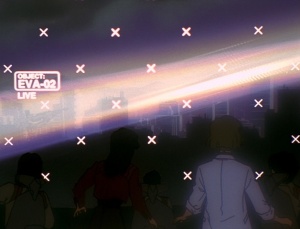 |
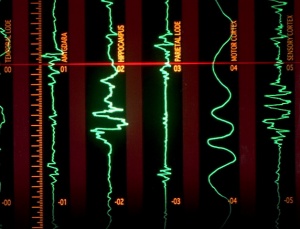 |
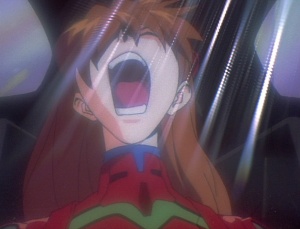
|
|
22. Bölümden Kesitler
- A) Bu çekimde, Tokyo-3'te Evangelion Ünite-2'yi hedef alan bir ışık huzmesi görüyoruz. NERV üyeleri onu endişeyle izliyorlar. Ama tam olarak ne oluyor? Bu ne tür bir havari saldırısı? Görüldüğü gibi, bu görüntü kendi başına eksiktir ve sonraki görüntüleri olmadan çok az anlamı olan bir çekim olacaktır.
- B) Şimdi, bilgisayar terminallerinden birinin Asuka'nın beyin dalgaları gibi görünen şeylerle ilgili istatistikleri okuyan bir sahne var. Görüldüğü gibi, dalgalar keskin bir şekilde yükseldi. Bir şeyler oluyor ama tam olarak ne olduğu belirsiz. Bu çekim, ilkinin daha büyük anlamı üzerine inşa edildi ve bu, montajı anlamada bir adımdır. Ancak bundan sonrası aslında montajın doğasını ortaya çıkaracaktır.
- C) Ve anlamı var! Asuka, havari tarafından saldırıya uğradı, yani en büyük korkularımız gerçekleşti. Işık, gökkuşağı ve ardından Asuka'nın kendisi, birbiri üzerine inşa edildiğinde izleyiciye bağlam ve anlam verebilen çekimlerdi. Bu, bu üç görüntünün çok basit ve bariz bir yapısökümü gibi görünse de, bölümün ilerleyen dakikalarında Asuka'nın hızlı tempolu montajlarındaki görsel uyumsuzluğu gerçekten değerlendirmeye gelince, bu tür temel bilgiler orada olmalı, aksi takdirde montaj görüntülerine ayrı varlıklarda bakacağız. Montaj sekansının kendisinde daha büyük bir meta-anlamı kaybetmesi nedeniyle bu riske atılamaz.
|
Anno bu tekniklerde ne kadar usta?
Bu temel yönleri göz önünde bulundurarak, Anno'nun Eisenstein'ın teorik makalelerinden herhangi biriyle karşılaşıp karşılaşmadığının şu anda belirsiz olduğu bilinmelidir. Herhangi bir noktada iyi film ya da animasyon öğrencisi olmalı, çünkü teorileri modern sinemanın gelişimi için son derece önemliydi, ancak Anno'nun iyi bir film öğrencisi olarak statüsünün bir soru meselesi olduğu anlaşılmalıdır; bir başka önemli montaj teorisyeni olan Jean Luc Godard'a aşina olduğunu kabul ettiği düşünülebilir ama Godard'ın tekniklerini benzer bir şekilde kullanan birkaç Japon film yapımcısına da aşina olmuştur.
Bununla birlikte, montaj ve arkasındaki teori, evrensel film yapım diline az çok özümsenmiştir. Anno'nun konuya aşinalığı hâlâ söz konusu olduğu için bu montaj teorilerinin alakasız olduğunu söylemek gerekirse, büyük ihtimalle sadece bir tane yapabilmekle bu konuda bilgi sahibi olduğu söylenebilir.
22. Bölüm
En dikkat çekici montaj sekansları, Asuka'nın en derin, en karanlık anılarının yüzeye çıkarıldığı ve güvensizliklerinin daha da artmasına sebebiyet veren "zihin ihlali" sahnelerinde sunulanlardır. Zorla iç gözlemi doruk noktasına ulaştığında, izleyiciye kelimenin tam anlamıyla Asuka'nın tam bir yapısökümü sunulur. Önümüze serilmiş düşüncelerini, arzularını ve duygularını görüyoruz ve Asuka'nın aşağı doğru sarmalının başladığını, Öteki'yi reddetmesinin başladığını gördüğümüz bir noktaya ulaşıyoruz, en önemlisi üç varlıkta tezahür ediyor: Annesi, Kaji ve Shinji.
İşte bu zihin ihlali montajlarının son hali:
| Montage Sequence
|
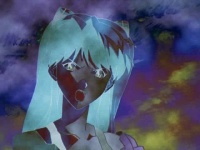 |
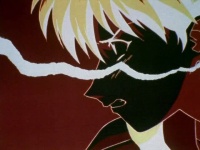 |
 |
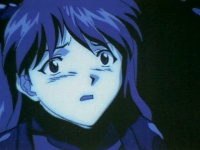
|
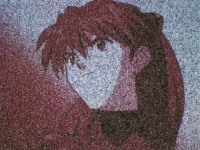 |
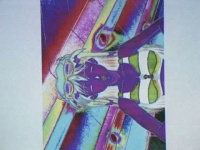 |
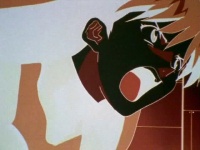 |
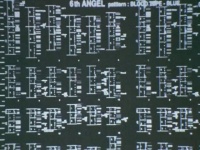
|
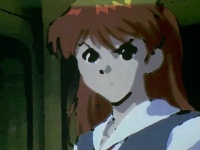 |
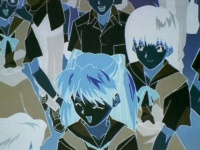 |
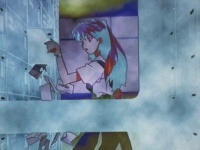 |
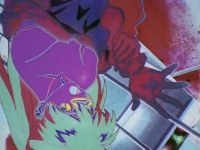
|
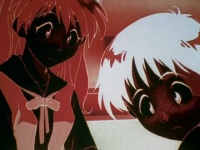 |
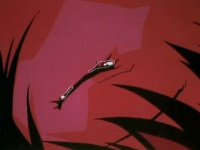 |
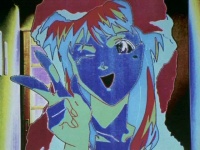 |
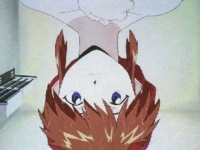
|
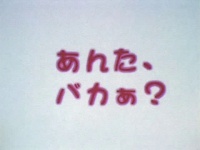 |
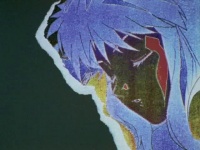 |
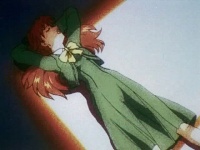 |
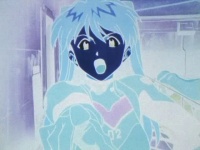
|
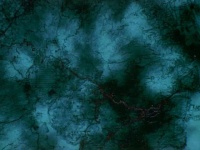 |
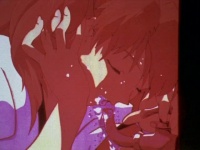 |
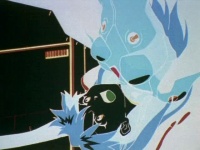 |
|
|
Episode #22 Cuts
- What we see are twenty-three different images, shots of Asuka in various emotional states, even information on the 6th angel, and what seems to be like a cracking facade. These, though they may seem like disconnected images, are actually all images that follow particular themes that pay off in a particularly interesting way in relation to the forced introspection on the part of Asuka
- Shots 1-4: What we see are two images of Asuka-- one condescending, and one of a determined/angry look on Asuka's face. But there is most notably a "tear" in the shot, which indicates either a tear, or crack in Asuka's personality. This is to say that this is not the complete and true person of Asuka, as we have seen now. But, the two images are also speaking in a narrrative sense. At the outset of the narrative, Asuka was both of these, but we know that this was just a facade put on by her, hence the shot of Tokyo-3's facade. A face of a mortified Asuka is the first of several sub-payoffs, shots that reinforce statements made by the previous shots, and act as transitions in this case. Asuka realizes that these two things are not hwe true self -- but her is questioning, as well, what is her true nature? And what defines it?
- Shots 5-16: We see another determined look on the part of Asuka, but what is she determined about? The next shot confirms what: Shinji. She is wearing the same bathing suit that she wore in Episode 10. But is this just some good-humored flirtation on Asuka's part? Asuka again looks determined, a shot that also suggests that she is revving up her Eva. The next shot confirms it: Angel number six. Asuka's first time in combat. And what happens? She allows Shinji, to enter the heart (or womb, if one takes the Freudian approach), you might say, if one were to think of it in such a manner. Asuka is inviting Shinji into something sacred: what she truly only sees as an identifying body: her Eva, and her status as an Eva pilot. We see, in essence, an acceptance of Shinji as a potential significant other. Note the Eva=Mother/Shinji=Significant Other dichotomy.
- Next we have Asuka in a school uniform. This is the first time she is in one, and she does not look thrilled. But we see a totally different expression on Asuka's face in the next shot. Why? This is another well placed reinforcement about Asuka's own projected images of herself as the "popular foreign girl". Her displeasure at the love letters in her gym locker confirms this. She is not attempting to impress these other boys -- she is trying to impress the person (people, possibly including Kaji) who she has been "going after" -- Shinji.
- Next we see shots furthering the Asuka/Shinji theme of this montage. Asuka angry over Shinji's pervertedness -- but notice the placement of the shot. It is upside down -- my theory behinf this is that turning the shot upside down is a method of refuting the content and subtext within the shot. That is to say that Asuka seems embarrassment over the implication of Shinji's pervertedness, but in an equally perverted way, she wants his gaze. The relationship implication "the newlyweds", Toji said, embarrasses both Shinji and Asuka. Judging by the usual anime-implications of the notable "full-face" blush, both of them want the relationship to occur -- it is just that Asuka is exploring, albeit awkwardly, the feasibility of the relationship, and that Shinji is perhaps blushing over Toji's perceptiveness, along with his own inability to reach out to Asuka.
- Next, we have a shot of real vulnerability. Asuka's sobbing over her mother as she sleeps in Shinji's bed. Again we are returning to an exploration of the mother vs. significant other theme. The next shot is more overt flirtatiousness on the part of Asuka. Again, this is more attention getting behavior on her part, sexualizing herself for the male gaze.
- Finally, the key statement made in this sub-montage: She, throughout the series, actively rejected her statement of hatred of Shinji in Episode 22. She is reacting adversely to the inability of Shinji to properly respond, but she still wants him.
- Shots 17-23: The conclusion of sorts. We see an inter-title that reads "Are you stupid?". This quote, almost always directed at Shinji, rings especially true. "Are you stupid," she asks, "because you refuse to respond to me?!". With her going as far as climbing into his bed, shown in the next shot, and canceling a date with another boy, shown in the shot after that, she is justifiably angry. The next shot builds on the "are you stupid theme", an almost fully accusative shot, pointing a finger at Shinji.
- In the final three shots, we will finally reach the conclusion, the climax, the major statement that this montage has been building up to. We see a misty scene, so what we can imply is that there is a truth needing to be unveiled, a secret code needing to be cracked: What does Asuka want? In what seems to be a phallic allegory, the answer is simply: Shinji. And with the final shot of her piloting flipped, one can only assume that this realization has turned all of her facades, defense mechanisms, and her justification for existence completely upside-down.
|
| Montage Sequence
|
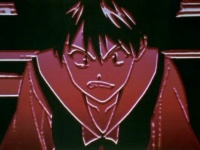 |
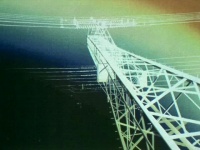 |
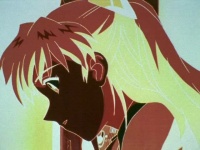 |
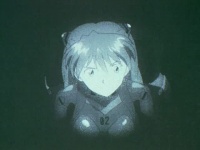
|
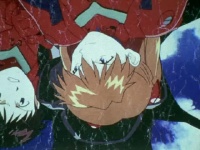 |
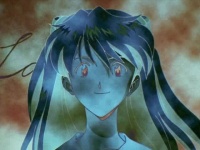 |
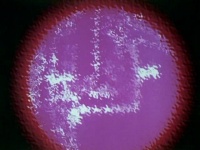 |
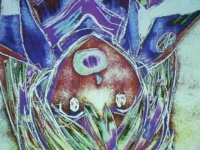
|
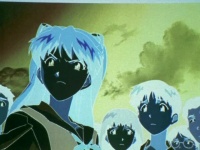 |
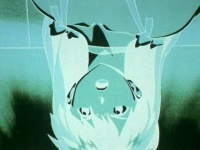 |
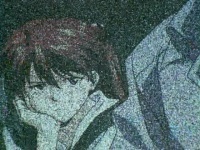 |
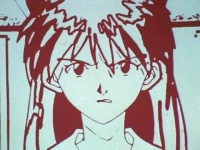
|
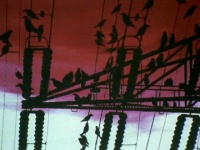 |
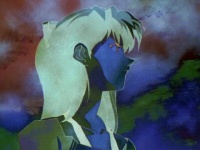 |
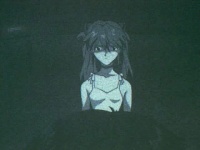 |
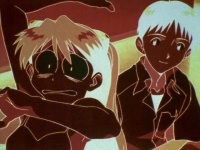
|
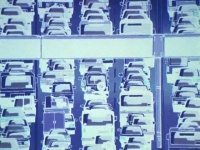 |
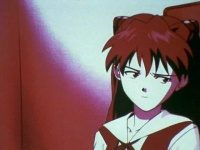 |
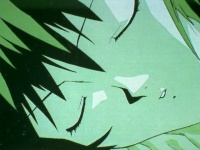 |
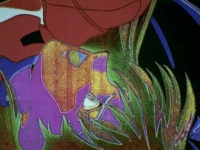
|
|
"Episode 22 Cuts"
- SHOTS 1-7: What opens the montage is one of Asuka in anger, followed by a screenshot of an electric transformer tower. Admittedly, the meaning is ambiguous, but the most sensible interpretation is that Asuka is angry at a constructed, unattainable complex that she herself has molded. The next shots seem to reinforce this. In the next sequence, we see an Asuka who is looking into her "true self", a self lost in blackness, constricted, captured, by an outer self that is a determined , almost to the point of hostile, Eva pilot, and of course, the bubblegum pop version of herself that she presents at school. She is none of these things. The next shot, a periscope that seems to be looking at a spiral drill, probably Matariel's. This is probably an allusion to "digging deeper", or "getting to the core" of Asuka's existence, and her problems.
- SHOTS 8-17: What we see next is a shot of a very condescending Asuka. She is looking down on someone, something -- but the question is, why? Who is she to look down on someone? A girl who cannot even handle herself? And to whom is she looking for approval from, if anyone? Another shot of her looking condescending is flipped upside down, a further refutement of the sentiment. The next shot answers the question: Asuka is looking for the approval of none other than Shinji. She wants him to notice her, to respond to her, somehow.
- Obviously, this angers her, his usual lack of response or incorrect response to any of her advances. She feels that she is just another crow on the wire, so to speak, as evidenced by this shot -- and is maddened by it. This is followed by a look of determination -- something is driving her to separate herself, to become acknowledged, but what and by whom? The next shot again answers, she is looking at Shinji, for his response. It seems, however, that the next shot of her acting wildly seems to reinforce the impression that Shinji will only notice her if she acts out, if she treats him poorly or acts flamboyantly. If she doesn't do so, she will only be another face in the crowd, or car on the road, as exemplified in the following shot.
- SHOTS 18-20: What we see in shot eighteen is the beginning of Asuka's final conceit, her conclusion. She is a failed romantic, opening herself up to Shinji but failing miserably, and her physical failure of being an Eva pilot who can no longer produce successful results. This conclusion, this payoff shot(s) begs the question for Asuka: to where do you go from here?
SHOTS 18-20
|
| Flash-sign Montage Sequence 3
|
 |
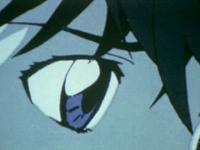 |
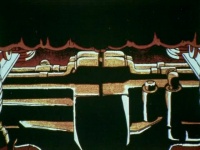 |
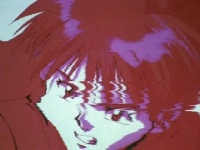
|
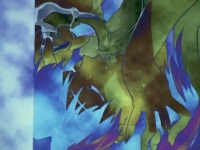 |
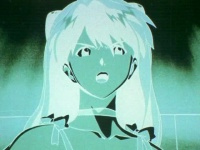 |
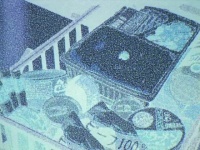 |
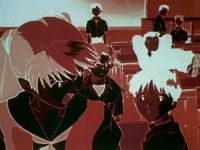
|
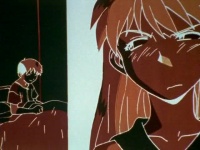 |
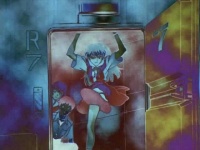 |
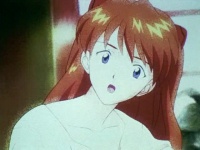 |
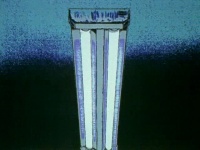
|
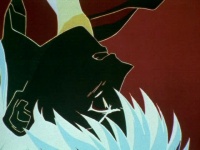 |
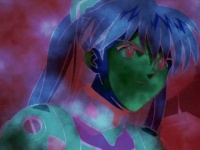 |
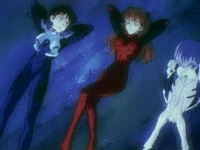 |
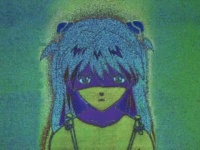
|
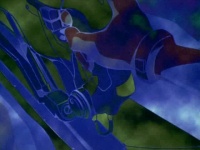 |
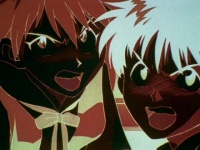 |
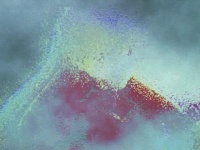 |

|
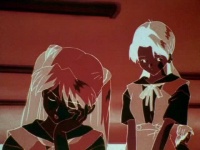 |
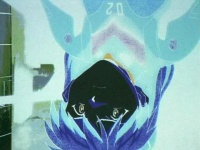 |
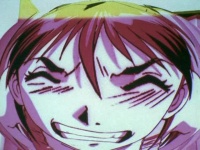 |
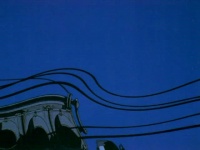
|
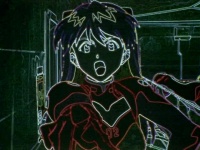 |
|
|
|
|
"Episode 22 Cuts"
- SHOTS 1-10: While the statement "I can live on my own!" blares on in the background -- we first see that side of Asuka that is so connected to the other -- her "projected self". The next shot is Asuka staring, but at what? Following this, we see another piece of machinery -- most likely a traincar linkage, implying that she is indeed linked to others. We see a face of Asuka's anger -- but at what? The only interpretation is at the thing that she is trying to force upon herself -- the fact that she "can live on [her] own!" Then the phallic shot -- but it is inverted, and discolored. Is she angry at her own statement that she can't live without Shinji? What we see next is the same picture we have seen in the previous montages. This will be from now on called the "command Asuka" because in Episode 8, where this screen-cap is taken, this shot is Asuka telling Shinji to follow her (in order to show off her Eva). But what is she commanding? Food, or the production of it. Who is the cook in the Katsuragi residence? Shinji, which Asuka realizes, turning round in the next shot. And like it or not, she really does care about his well-being, even if embarrassed to show it. But once again, this begs the question -- why does she hide her emotions like that? Is it the fear of rejection and/or something more?
- SHOTS 11-21: The next shots seem to answer whatever questions are left to be answered: Asuka wants to "lead the charge", and "make the first move" [screencap from just before Episode 15 kiss scene], shedding light on her domestic troubles. This, I believe opens up a whole new dimension in the realm of the "synthetic family", something that should be explored in further detail. It truly seems to "shed light" (next shot) on her troubles in piloting the Eva (following shot). Asuka looks at her superiority over the other Eva pilots, both suggested in the shot itself, and in the context of the earlier episodes, where she had generally a higher sync ratio. Her broken self (EoTV screenshot again, where she was really laid out to bare her emotions full-on), was completely justified by her control, reacting negatively when it was implied otherwise, as evidenced in the defensiveness of Toji implying a relationship that she was not "entirely in-control of".
- The next shot deserves notice in the fact that it is a screenshot of Asuka "fading away". This is probably alluding to the feeling of "fading away" that she feels when not being bombastic, and fully in control of any situation. If she is not, then she is just another car in the train, so to speak.
SHOTS 22-25: But the only way she can maintain this control, it seems, is by making others feel inferior, thus driving them away from her. With no one to control, she is no one. Normally, being this terrible to people, being this commanding, would be anathema to most, but the next shot of Asuka looking on in terror is inverted -- revealing that she is not terrified at her own mental creation, but, as the next shot proves, thrilled, insanely, maddeningly happy about it. This, amplified by the the fish-eye lens, and the following distorted shot, seems to show that Asuka is indeed twisted. And if that was not enough, the montage ends with the "accusative Asuka", effectively saying: "THIS IS YOU."
|
It is apparent in the context of the montages as well, even the mindrape itself, Asuka is continually placed in positions of weakness. This is evidenced by the "Arael avatar" standing over the fetal-position, naked Asuka, and the "one of many" crowd scene. More on this later, because I am awaiting feedback.
- For differing opinions and discussions about these images, please take a look at this thread
Subverting Wide-Shot stereotypes in Episode 24 of Neon Genesis Evangelion
There is a reasonable adage about the use of the wide or extreme-wide shot in anime series: they are used to save money. With the audience lacking the ability to see the small mouth movements, the animators are able to save frames, and save funds on the production budget. However, amongst fans of a more visceral type, these shots can often seem “lazy” at best, or seemingly a forewarning of a rapidly failing production.
Evangelion was no stranger to these production troubles-- the ship was sinking fast around the time that the last five or so episodes were made. But that being said, these wide shots do not seem to fit the usual “lazy” stereotype that seems to fit so well on the mantle of other anime series that were made with much less directorial care than Evangelion. In fact, in a way startling similar to other media that have used the wide shot, these compositions often give the impression of a “painting” rather than simply a frame of animation.
Following Eisenstein's memorable words that “cinema is a synthesis between art and industry”, there is no reason why the “budget-saving” wide shots in Evangelion can't be artistic. With the help of some sub textual readings into the wide shots on both a narrative and technical level, this essay hopes to present that Evangelion's wide shots are indeed a manifestation of Eisenstein's synthesis.
For the sake of reference, the following wide shots will be used for the sake of this argument:
| Episode 24 Wide Shots
|
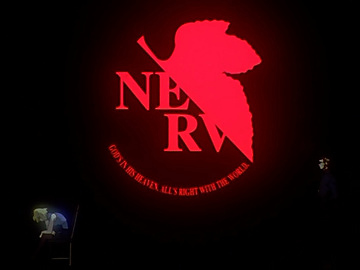 |
|
|
|
|
|
|
|
|
Ritsuko: Commander Ikari,My cat died, which my grandmother had been taking care of. I hadn't been taking care of it for long time... Suddenly now, I cannot see it again.
Gendou: Why did you destroy the Dummy System?
Ritsuko: It's not the dummy system, but Rei that I destroyed.
Gendou: I ask you once more. Why?
Ritsuko: Now that I am not happy even if you hold me. You can do anything you like to my body, as you did that time.
Gendou: I am disappointed in you.
Ritsuko: Disappointed? You have never expected anything from me in the first place. I have, nothing, nothing ...what shall I do, mom..
|
1.This shot is manifold in dichotomy. First we have what is the obvious: Ritsuko mourning the loss of her cat, and Gendo angry over the loss of the dummy system. But what we have here goes a little deeper than that: What we see now is a Ritsuko who has lost all love for her work, and a Gendo who is working for his love. This shot is a manifestation of the things that it cost the two of them: Ritsuko has lost the things that gave her life justification, Gendo has lost his “soul” and empathy in the process of executing his plan for instrumentality.
2.What goes even deeper is the symbol that sits in the middle of the two of them: a glowing symbol of NERV. What we can see here is the organization and symbol that brought the two of them together, and then drove the two apart. Unlike the previous image where the composition isn't as important as the words being spoken, here we have an image of the very essence of their relationship. For Gendo, NERV is a tool to retrieve his wife. Thus, for the most part he treats those who are a part of it like tools. His emotional detachment to many of the characters is quite obvious throughout the series. For Ritsuko, however, NERV is the justification for her being, what makes Ritsuko Ritsuko is NERV itself, and she treats it very seriously. A classic “conflict of interests” manifested through the organization itself is brilliantly played in this scene through both words and visuals.
1.This shot is manifold in dichotomy. First we have what is the obvious: Ritsuko mourning the loss of her cat, and Gendo angry over the loss of the dummy system. But what we have here goes a little deeper than that: What we see now is a Ritsuko who has lost all love for her work, and a Gendo who is working for his love. This shot is a manifestation of the things that it cost the two of them: Ritsuko has lost the things that gave her life justification, Gendo has lost his “soul” and empathy in the process of executing his plan for instrumentality.
2.What goes even deeper is the symbol that sits in the middle of the two of them: a glowing symbol of NERV. What we can see here is the organization and symbol that brought the two of them together, and then drove the two apart. Unlike the previous image where the composition isn't as important as the words being spoken, here we have an image of the very essence of their relationship. For Gendo, NERV is a tool to retrieve his wife. Thus, for the most part he treats those who are a part of it like tools. His emotional detachment to many of the characters is quite obvious throughout the series. For Ritsuko, however, NERV is the justification for her being, what makes Ritsuko Ritsuko is NERV itself, and she treats it very seriously. A classic “conflict of interests” manifested through the organization itself is brilliantly played in this scene through both words and visuals.
1.This shot is manifold in dichotomy. First we have what is the obvious: Ritsuko mourning the loss of her cat, and Gendo angry over the loss of the dummy system. But what we have here goes a little deeper than that: What we see now is a Ritsuko who has lost all love for her work, and a Gendo who is working for his love. This shot is a manifestation of the things that it cost the two of them: Ritsuko has lost the things that gave her life justification, Gendo has lost his “soul” and empathy in the process of executing his plan for instrumentality.
2.What goes even deeper is the symbol that sits in the middle of the two of them: a glowing symbol of NERV. What we can see here is the organization and symbol that brought the two of them together, and then drove the two apart. Unlike the previous image where the composition isn't as important as the words being spoken, here we have an image of the very essence of their relationship. For Gendo, NERV is a tool to retrieve his wife. Thus, for the most part he treats those who are a part of it like tools. His emotional detachment to many of the characters is quite obvious throughout the series. For Ritsuko, however, NERV is the justification for her being, what makes Ritsuko Ritsuko is NERV itself, and she treats it very seriously. A classic “conflict of interests” manifested through the organization itself is brilliantly played in this scene through both words and visuals.

















































